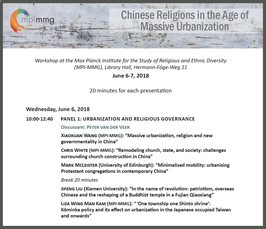"Chinese Religions in the Age of Massive Urbanization"
Workshops, conferences 2018
- Start: Jun 6, 2018 10:00 AM (Local Time Germany)
- End: Jun 7, 2018 03:10 PM
- Location: MPI-MMG, Goettingen
- Room: Library Hall

For more details please contact vdvoffice(at)mmg.mpg.de.
In the light of such a gigantic state-led urbanization project, scholars working from sociological, anthropological and historical viewpoints are invited to consider the associated questions on how urbanization and religion constitute each other and the implications of broad changes resulting from urbanization and the dynamics of religion. We do not take “urban” as self-evident nor a given, nor do we “use religion as a thing that can be easily distinguished from the flow of social life in cities.” Our goal is to use religion “as a lens through which one can acquire a better view of what urban aspirations are” and to interrogate the rural and urban divide. To these ends, we ask a range of questions including but not limited to:
- How does urbanization transform religious practices, beliefs and organization as religious communities face new issues and challenges? For instance, to what extent is the rise of neo-Calvinist style Christianity (as opposed to Pentecostal style Christianity) related to the extensive process of urbanization? How much has urban expansion shaped the ways that house churches congregate and operate? Similar questions can be asked of other religious traditions.
- How do city planners envision and position religious space in Chinese cities? How are religious spaces contested, transformed, negotiated and [re]produced in those (soon-to-be) urban areas among a constellation of actors from officials, urban developers, to neighborhood residents and religious leaders? To what extent has urbanization been reshaping the ways that various religious traditions engage with local place, environment, their constituencies, and the government as well as each other?
- What role does religion play in this process of urbanization in China? How much does religion and religious conversion in cities address such new issues confronting urban migrants as joblessness, housing, health and social welfare? How much does religion protect and how much does it exploit urban migrants' interests?
- How significant are religious organizations and groupings for urban migrants of different regional and ethnic origins, including Han or Chinese minorities? From a historical perspective, how can they be compared to 'native place' associations and temples existing in cities before 1949? Does religion among Chinese migrants mean the same thing for those settled in megacities outside China and those within China?